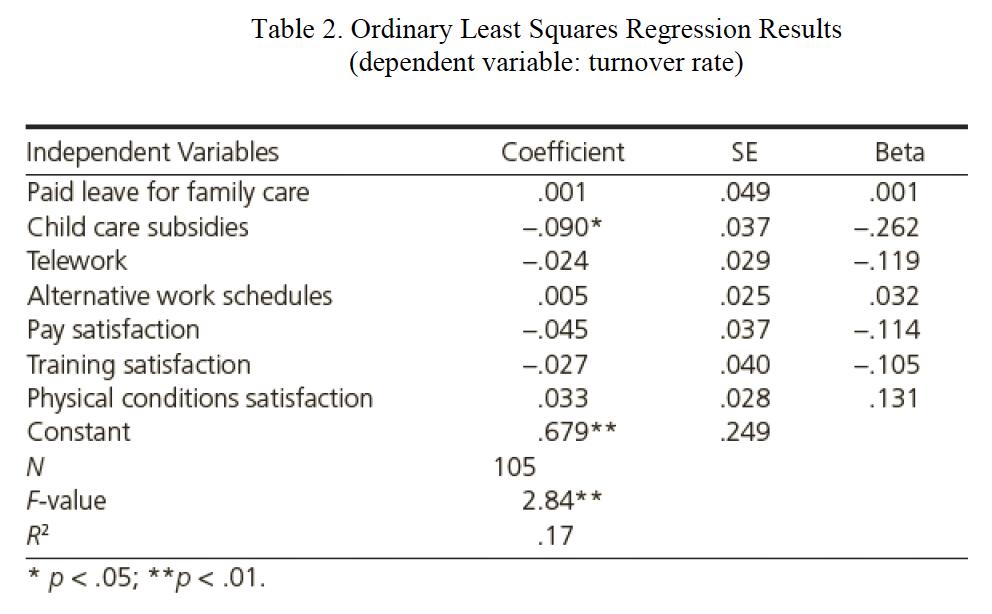Question
Family-friendly policies are broadly defined as a group of complementary benefits and programs designed to support employees who are faced with balancing the conflicting demands
Family-friendly policies are broadly defined as a group of complementary benefits and programs designed to support employees who are faced with balancing the conflicting demands of work, family, and personal time in today’s complex environment. Family-friendly policies that U.S. federal agencies are providing include alternative work schedules, telecommuting or telework, part-time employment, job sharing, dependent care programs, child care services, leave for family responsibilities, and so on. These family-friendly policies are formulated and implemented because they are believed to benefit both employers and employees. However, existing empirical evidence on the effect of family-friendly policies on government agencies is very mixed.
In 2011, Lee and Hong published a study “Does Family-Friendly Policy Matter? Testing Its Impact on Turnover and Performance” in Public Administration Review, exploring the relative impacts of four family-friendly policies—child care subsidies, telework, paid leave for family care, and alternative work schedules—on federal employees’ turnover rate, using data from 105 federal agencies. The variables used in the analysis are explained in the table below:
Dependent Variable | Definition |
Turnover rate | Percentage of employee who leave voluntarily in a given fiscal year out of the number of total employees |
Independent Variables | Definition |
Paid leave for family care | Level of employee satisfaction with paid leave for family care within an agency (from 1 to 5, 1 being very poor and 5 being very good) |
Child care subsidies | Level of employee satisfaction with child care subsidies within an agency (from 1 to 5, 1 being very poor and 5 being very good) |
Telework | Level of employee satisfaction with telework within an agency (from 1 to 5, 1 being very poor and 5 being very good) |
Alternative work schedules | Level of employee satisfaction with alternative work schedules within an agency (from 1 to 5, 1 being very poor and 5 being very good) |
Pay satisfaction | Level of employee satisfaction with their pay within an agency (from 1 to 5, 1 being very poor and 5 being very good) |
Training satisfaction | Level of employee satisfaction with job training within an agency (from 1 to 5, 1 being very poor and 5 being very good) |
Physical condition satisfaction | Level of employee satisfaction with worksite’s physical condition within an agency (from 1 to 5, 1 being very poor and 5 being very good) |
* Telework is a work arrangement in which an employee regularly performs officially assigned duties at home or at other worksites that are geographically convenient to the residence of the employee.
After running a regression using the data, the authors report their findings in Table 2.
Table 2. Ordinary Least Squares Regression Results (dependent variable: turnover rate)

Analyze the results in Table 2:
(1) Write out the regression equation.
(2) Explain the effect of each family-friendly policy on employee turnover, by interpreting the its slope and assessing its statistical significance. Does that policy have a statistically significant impact on employee turnover?
A. Paid leave for family care
B. Child care subsidies
C. Telework
D. Alternative work schedules
(3) Interpret R2.
(4) Based on beta coefficients, which independent variable has the largest effect on employee turnover?
Table 2. Ordinary Least Squares Regression Results (dependent variable: turnover rate) Independent Variables Paid leave for family care Coefficient SE Beta .001 .049 .001 Child care subsidies -.090* .037 -.262 Telework -.024 .029 -119 Alternative work schedules Pay satisfaction Training satisfaction Physical conditions satisfaction .005 .025 .032 -.045 .037 -.114 -.027 .040 -.105 .033 .028 .131 Constant .679** .249 105 F-value 2.84** R2 .17 *p
Step by Step Solution
3.45 Rating (164 Votes )
There are 3 Steps involved in it
Step: 1
Teleworkers An agency must determine and designate the official worksite for an ...
Get Instant Access to Expert-Tailored Solutions
See step-by-step solutions with expert insights and AI powered tools for academic success
Step: 2

Step: 3

Ace Your Homework with AI
Get the answers you need in no time with our AI-driven, step-by-step assistance
Get Started


